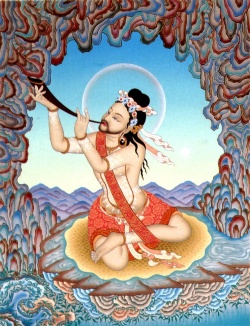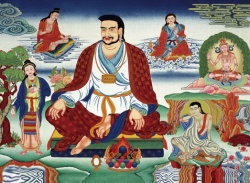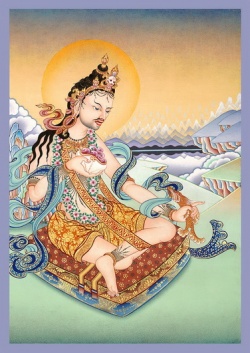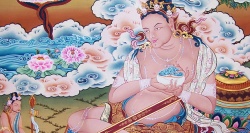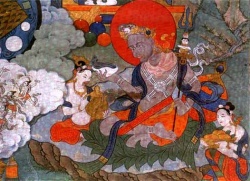Original sources of the six yogas
As with all Buddhist teachings, tradition claims that the original source of the Six Yogas of Naropa is none other than the Buddha himself, w ho 2,500 years ago taught many different sutras and tantras, the former being his open discourses and the latter his secret Vajrayana discourses. The Six Yogas of Naropa is a synthesis of numerous tantric doctrines embodied in the original tantras taught by the Buddha. This is explained by Lama Tsongkhapa in A Book of Three Inspirations, The instruction on the inner heat yoga comes to us through Tilopa, who commented that this was the transmission of the mahasiddha Krishnacharya, also known [to Tibetans) as Lobpon Acharyapa, which fuses [the teachings
on inner heat yoga found in] the Hevajra Tantra and the Heruka Chakrasamvara Tantra....
The illusory body and the clear light doctrines are derived from the oral tradition teachings of the Guhyasamaja Tantra, as transmitted through the Indian mahasiddha Jnanagarbha. This Marpa tradition of the Guhyasamaja oral instruction transmission has been used as the basis, with embellishments from the Guhyasamaja transmission of the Aryas, Father and Sons [i.e., Nagarjuna and his disciples Aryadeva and Chandrakirti). The practices of consciousness transference and forceful projection to a new residence are based primarily on the Shri Chaturpita Tantra,4 Thus all six of the Naropa yogas are sourced in original tantric texts taught by the Buddha. The inner heat yoga is a fusion of those practices taught in the Hevajra Tantra and the Heruka Chakrasamvara Tantra; 20 Readings on the Six Yogas of Naropa the illusory body and clear light yogas are based on the Guhvasamaja Tantra; and both consciousness transference and forceful projection yogas are based on the Shri Chaturpita Tantra.
All of these original tantras were taught by the Buddha. Here Lama Tsongkhapa does not mention the bardo yoga separately, for in the Six Yogas tradition this is treated as an extension of the illusory body yoga, and thus is also based on the Guhyasamaja Tantra. All of these original tantras were translated from Sanskrit into Tibetan and are preserved in the Kangyur canon. In addition, numerous commentaries to them by later Indian masters are preserved in the Tengyur.
Tsongkhapa points out that for the Six Yogas tradition the most important of the Indian commentaries is Krishnacharva's treatise on the inner heat yoga.
THE NAME OF THE TRANSMISSION
As we will see later in Chapter One, which contains Tilopa's brief verse work on the Six Yogas, Tilopa primarily drew from four Indian lineages in formulating the system that would become known to history as the Six Yogas. The title of his text was probably given retroactively by the Tibetans; it is a guide to what is known as "Tilopa's Four Instructions," which when translated into yogic practice become the Six Yogas.
The title of the slightly longer verse work by Tilopa's Indian disciple Naropa, after whom the Tibetans named the system, was probably also given retroactively by the Tibetans. This is indicated bv the fact that in the early days of the lineage in Tibet there were traditions of speaking of two, three, four, six, eight and ten yogas. Had both Tilopa and Naropa spoken specifically of six yogas, as the names of their two texts would seem to imply, the Tibetans would automatically have followed this lead, and there would not be a tradition of speaking of differing numbers of yogas.
In fact the name of the text given in its colophon is The Vajra Verses: An Instruction to Jnana Dakin:: the official title under which it appears in the Tengyur—Vajra Verses of the Whispered Tradition—is not mentioned in the text itself. In all probability it was Milarepa's chief disciple Gampopa, whose work produced the Dakpo Kargyu school (which later branched into the Four Older and Eight Younger Kargyu subsects), who popularized the name the "Six Yogas of Naropa." A brief treatise using the name "the Six Yogas" appears in his Collected Works. Of course the Translator's Introduction 21 phrase also exists in Milarepa's biography; but this was composed several generations later and again probably introduces the terminology retroactively. It seems that Marpa and Milarepa mostly referred to the lineage as "the Oral Instruction Transmission for Achieving Liberation in the Bardo."
Lama Jey Tsongkhapa refers to this name in the introductory section of his longer commentary, A Book of Three Inspirations, wherein he discusses the necessity for achieving maturity in the basic Buddhist practices before engaging in advanced tantric trainings such as the Six Yogas of Naropa. He writes, It is recorded that when Venerable Milarepa taught the oral instruction transmission for achieving liberation in the bardo he said, "First establish the basics, such as Refuge in the Three Jewels, the two aspects of the enlightenment mind—aspirational and engaged— and so forth.5 Otherwise both (guru and disciple will fall over the precipice of spiritual disaster, like two oxen yoked together...."
The above expression "the oral instruction transmission for achieving liberation in the bardo" is synonymous [with the Six Yogas of Naropa). In Chapter Four we will see more on this name for the Six Yogas tradition, "the oral instruction transmission for achieving liberation in the bardo," when Gyalwa Wensapa, a wonderful fifteenth-century Gelukpa lama and yogi who spent much of his life in retreat, discusses the Six Yogas from the perspective of how they relate to the process of blending the three kayas with the three bardos, or in-between states: the bardo of waking state consciousness; the bardo of sleep and dreams; and the bardo between death and rebirth.
This process is also known as "the three blendings," which is another name for the Six Yogas system.
THE LIVING TRADITION
The Six Yogas of Naropa has inspired meditators of Central Asia for a thousand years now, and continues to be as popular as ever. It is practiced to some extent in all sects of Tibetan Buddhism, although is especially popular in the Kargyu and Geluk schools. During the twelve years that I lived with the Tibetan refugees in India I had the wonderful fortune to encounter many yogis who were well established in the practice.
There were always a dozen or so Gelukpa monks and nuns dedicated to the training who lived in the caves and huts in the mountains above Dharamsala. Forty miles southeast along the Himalayas, in the 22 Readings on the Six Yogas of Naropa Tibetan settlement of Tashi Jong, the long-haired tokden yogis of the Drukpa Kargyu school underwent six-year retreats in the Six Yogas. Another fifty miles southeast at Manali, high in the mountains of the Kulu Valley, His Eminence Apo Rinpochey constantly trained groups of Ladakhi monks in the system. Other groups pursued the Six Yogas training in other parts of the Himalayas. To mention but a few, there were Karma Kargyupas in the hills above Rumtek, Sikkim; Shangpa
Kargyupas in the mountains above Darjeeling; Drikung Kargyupas in the caves and hermitages of Ladakh; Drukpa Kargyupas in Bhutan; and Nyingmapas in Nepal.
All of these monks, nuns, yogis and yoginis upheld and continued the ancient lineage of the Six Yogas descending from Tilopa, Naropa, Marpa and Milarepa. Each of the different schools of Tibetan Buddhism has developed the Six Yogas tradition in its own individual way and brought a unique character and flavor to the legacy. The Geluk school has made its own contributions in this respect, and I hope that my two books on the Six Yogas somewhat reflect this. In Tsongkhapa's Six Yogas of Naropa I tried to convey a sense of the genius of Lama Jey Tsongkhapa and the vastness of his approach to the Six Yogas.
In this collection of readings on the Six Yogas I am attempting to show how the original tradition as laid out by Tilopa and Naropa, and as clarified by Lama Jey Tsongkhapa, has continued to inspire practitioners over the centuries and has come into the present era with both depth and power. The Oral Instruction of the Six Yogas Skt. Satadharma-wpadesa-nama Tib. Chos drug gi man ngag zhes by a ha by the Indian Mahasiddha Tilopa 988-1069 C.E.
The Indian master Tilopa is regarded as the formula tor of the Six Yogas system. He was born in 988 in Bengal to a brahmin family and as a youth helped support his family by tending buffaloes. This work gave him plenty of spare time, and as he sat in the fields with his herds he passed the hours first by learning to read and write, and then by studying and memorizing many of the great Buddhist scriptures.
By the tune he reached his teens he had become self-educated in the classics. After he reached adulthood he journeyed to Oddiyana (the present day Swat Valley of Pakistan), where he received numerous transmissions from a group of female mystics. Later he traveled widely and studied under many different Buddhist masters. He spent years in the intensive practice of meditation and eventually achieved enlightenment.1 His biography states that the main lineages he received and emphasized in his personal practice were the Madhyamaka doctrines and the Guhyasamaja Tantra transmissions descending from the mahasiddha Nagarjuna; the clear light and bardo doctrines of the mahasiddha Lawapa; the Heruka Chakrasamvara lineages descending from the mahasiddha Luipada; the Mahamudra lineages of the mahasiddha Shavari; and the inner heat doctrines of the Hevajra Tantra as transmitted through Krishnacharya.
In his later life Tilopa manifested countless miraculous activities in order to inspire and enlighten trainees. He could stop the sun in its path, shape-shift by changing himself into animal forms, fly through the sky, and visibly manifest tantric mandalas in space. Sometimes he lived quietly as a monk, and at others dwelled with corpses in charnel grounds.
To provide conditions by which beings could collect merit he sometimes sustained himself by begging for alms, sometimes by operating a whore-house. Tilopa's name, in the colophon to our text spelled "Tillipa," means "Sesame-seed Man." He earned this name because as a part of his enlightenment path he worked as a ponder of sesame seeds for producing oil, taking his work as a metaphor for how the oil of enlightenment is extracted from the seed of mundane experience. He had many disciples, but the greatest of all was Naropa, to whom he transmitted the Six Yogas that he had formulated.
Several short texts on the Six Yogas that are attributed to Tilopa exist in Tibetan, but only the verse work herein translated was considered authentic beyond question, and therefore was the only one to be included in the Tibetan canon of Indian commentaries, the Tengyur. Tilopa's text is only a few verses in length but is nonetheless important in that it is the earliest known work on the Six Yogas. It mentions four important lineage masters from whom the Six Yogas had come to him: Krishnacharya, Nagarjuna, Lawapa and Sukhasiddhi.
These four are the sources of the longer list given above, as gleaned from his biography. In the translation I have added subheads giving the name of each of the six yogas. This may perhaps break the flow created by Tilopa's continuous style, but as compensation clarifies the ideas embodied in the work. Tilopa's arrangement of the Six Yogas seems to be slightly different from that which became popular in Tibet in the Pakmo Drupa Kargyu school and subsequently in the
Geluk.
He lists them as
(1) inner heat yoga from Krishnacharya, whom he refers to as Charyapa;
(2) illusory body yoga from Nagarjuna;
(3) dream yoga from Lawapa;
(4) clear light yoga, also from Nagarjuna;
(5) bardo yoga from Sukhasiddhi: and finally
(6) the consciousness transference and forceful projection yogas, also from Sukhasiddhi.2
My subheads indicate how they are grouped in the Pakmo Drupa Kargyu and Geluk schools. The Oral Instruction of the Six Yogas by the Indian Mahasiddha Tilopa Homage to Glorious Chakrasamvara. Take advantage of the karmic process4 And extract the essence of the human potential.
Source
[
